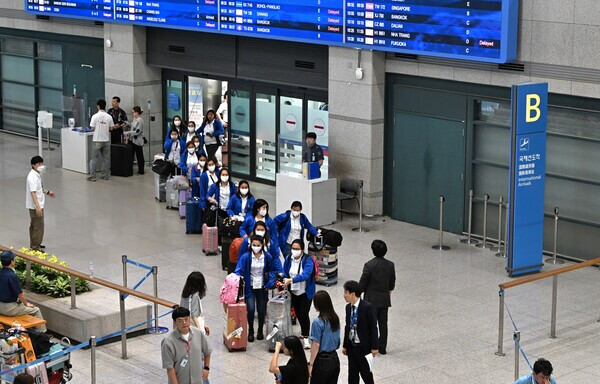
Seoul, South Korea – South Korea has officially entered an era where the number of foreign residents holding non-professional employment (E-9) visas surpasses 300,000, with a significant majority—approximately eight out of ten—employed in the mining and manufacturing sectors. This demographic shift highlights the critical role these workers play in sustaining key industries within the Korean economy. A recent report from Statistics Korea, released on May 18, 2024, provides a detailed breakdown of the living and employment conditions of immigrants by visa type, offering insights that build upon previous findings from December 2023.
The E-9 Visa Landscape: A Growing Workforce
As of December 2023, among the 1.561 million foreign residents in South Korea, 303,000 were E-9 visa holders, marking the first time this figure has exceeded the 300,000 threshold. An overwhelming 99.7% (302,000) of these individuals were employed, primarily through the Employment Permit System, which allows foreign non-professional workers to fill labor shortages in industries facing difficulties in recruiting domestic workers. This system is crucial for industries that rely on a steady supply of labor, particularly in sectors often avoided by Korean nationals due to the nature of the work.
Industry Concentrations: A Tale of Two Sectors
The report reveals distinct employment patterns across different visa categories. For E-9 visa holders, 80.5% are concentrated in the mining and manufacturing industries, followed by agriculture and forestry (14.4%) and construction (3.0%). This concentration underscores their indispensable contribution to the backbone of Korea's industrial output.
Interestingly, other visa categories also show a high proportion in manufacturing: professional workers (E-7 visa holders, typically skilled foreign professionals) at 50.5%, marriage immigrants (F-6 visa holders) at 34.4%, permanent residents (F-5 visa holders) at 32.7%, and overseas Koreans (F-4 visa holders) at 31.3% also show the highest proportion of their employment in the manufacturing sector. This suggests a broader reliance on foreign labor across various skill levels within the manufacturing sector.
In contrast, international students (D-2 and D-4 visa holders, who often work part-time) and visiting workers (H-2 visa holders, predominantly ethnic Koreans from China and former Soviet Union) are primarily employed in the wholesale, retail, accommodation, and food service sectors, accounting for 75.9% and 31.4% respectively. This reflects the flexible nature of their employment, often in roles that cater to daily consumer needs.
Income Levels and Living Conditions
Regarding monthly wages, the report indicates that 51.2% of foreign wage earners earn between 2 million and 3 million Korean Won (approximately $1,470 - $2,200 USD), while 37.1% earn over 3 million Korean Won. This income distribution varies by visa type. E-9 visa holders (70.8%), professional workers (50.5%), marriage immigrants (46.6%), and visiting workers (44.9%) most commonly fall within the 2 to 3 million won range.
However, permanent residents (55.2%) and overseas Koreans (46.1%) more frequently earn over 3 million won, suggesting higher earning potential due to potentially more stable jobs, longer tenure, or higher skill sets. International students, as expected, tend to have lower incomes, with 48.3% earning between 1 million and 2 million won, likely due to restrictions on their working hours and the nature of their part-time jobs.
Language Proficiency and Life Satisfaction
Korean language proficiency varies significantly among different visa groups. The average score for foreign residents was 3.4 out of 5. Permanent residents (4.3 points) and overseas Koreans (4.2 points) demonstrated the highest proficiency, followed by visiting workers (3.8 points). E-9 visa holders and professional workers scored lower, at 2.8 points each. This disparity highlights the need for targeted language support programs for certain groups to enhance their integration into Korean society.
Despite lower language proficiency, E-9 visa holders expressed the highest overall satisfaction with their lives in Korea, with an average score of 4.4 out of 5, exceeding the overall foreign resident average of 4.3 points. Visiting workers, international students, and overseas Koreans reported satisfaction levels slightly below the average (4.2 points). This high satisfaction among E-9 workers may be attributed to the stability of employment, the opportunity to earn higher wages compared to their home countries, and the structured support provided by the Employment Permit System.
Experiences with Discrimination
The survey also shed light on experiences with discrimination. 17.4% of all foreign residents reported experiencing discrimination. This figure was notably higher among international students (27.7%), professional workers (23.7%), and marriage immigrants (22.3%). In contrast, E-9 visa holders reported a lower rate of discrimination at 11.5%.
For E-9 visa holders who experienced discrimination, "Korean language ability" was cited as the primary reason (44.1%). However, for almost all other visa categories, "country of origin" was the most frequently cited reason for discrimination, indicating a broader issue of xenophobia and bias based on nationality.
Lee Hyung-il, Commissioner of Statistics Korea, expressed his hope that the data from the '2024 Survey on Immigrant Stay and Employment' will be actively utilized to analyze various aspects of foreign residents' lives in Korea. He emphasized that this data will contribute significantly to the establishment of effective immigration policies related to Korea's population, society, and economy. The report serves as a crucial resource for policymakers to understand the challenges and contributions of Korea's diverse foreign population, fostering a more inclusive and productive society.
[Copyright (c) Global Economic Times. All Rights Reserved.]



























